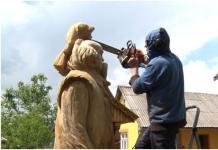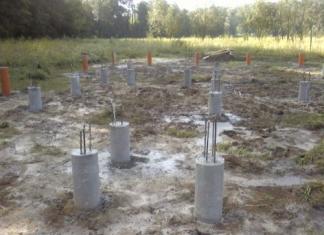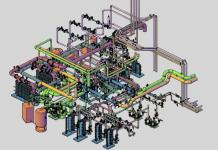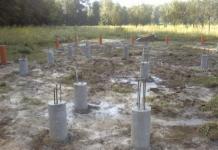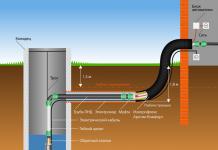- Nikolai Alekseevich, what definition of BIM, in your opinion, is the most accurate?
In my opinion, BIM is a database. This is an array of information that makes it possible to obtain almost any information about the projected object. This information can be presented in a variety of forms: graphical, textual, numerical. The most important thing is to structure it in such a way that the building owner can get exactly the data that he needs from the BIM model at any time. For example, at the design stage, this is information that can be provided to the customer or some authorities for approval, used to calculate the cost of construction, to select solutions that will be implemented already during operation.
How is this different from the traditional approach?
In the traditional sense, design is a stage of work that allows you to think through some details, aspects of a structure and then implement it in a construction site. BIM design allows, on the basis of the information that begins to be laid already at the concept stage, to manage the process, and at any stage: both at the construction stage and at the operation stage, and so on until the demolition of the building or its complete reconstruction.
- What kind of information is included in the BIM model?
If we talk about BIM design in terms of tools, then the information model is created using a whole set of software products. These are graphic programs that allow you to build geometry, such as Revit or MicroStation. Their peculiarity is that they can be used to build objects. If, for example, you build a door in a wall, then the program understands this door as an object, and not as a hole in a solid primitive. And then there is the binding of certain attributes to each object. Here the question is in the organization of this database itself and the degree of its saturation. This may be a minimal set of information, or it may be everything down to the materials used, handles, hinges, suppliers and the cost of fittings. If we are already talking about construction, this may be information about who installed, assembled this door, right down to the name of the installer. The time it was done. That is, information can be absolutely any and its form can be any. The question is only what we put into this BIM model, what we can “pull” out of it and in what form we present it.
- How often are such models used in construction?
Not often yet, but there are examples. There is such a system - Latista, it allows you to connect the information model with the construction process. In practice, it looks like this: technical supervision specialists walk around the site with tablets and note the detected shortcomings directly in them. These marks are tied to the coordinates of the BIM model, and in the future, all work is carried out in a virtual environment: instructions are given to the contractor, orders are formed, and so on. And all this is based precisely on the provision of relevant information.
- When did your company start using BIM?
Here it is necessary to separate BIM-modeling and three-dimensional modeling, because they are not quite the same thing. 3D modeling is geometry and BIM is information. We have been doing 3D modeling for a long time, and we have been using Revit for six or seven years. However, in general, the program helped us avoid some simple mistakes when designing buildings. But we approached full-fledged BIM-modeling only in the last two or three years. However, although we are building BIM models, at the end we still give the client a package of documentation, which theoretically could be developed using traditional methods. That is, with the help of BIM, we rationalize our own work, because BIM modeling tools allow us to avoid a purely human factor: somewhere something was not calculated or counted twice, somewhere something was forgotten to be indicated, and the like.
- In this case, is it possible to say that our request for BIM modeling still comes from designers, and not from customers?
In the last year and a half, there have been customers interested in BIM. However, in 70 - 80% of cases it is rather a tribute to fashion. Why do I say so? When communicating with clients who want to get a BIM model, I often understand how poorly they understand what it is and why they need it. There are not many who understand. But I think there will be more in the near future.
What are the real benefits of BIM modeling? How much in percentage terms can you save time and money?
I can't accurately answer this question, because there are no such statistics. To get it, the same work must be done twice: first in the traditional way, and then in BIM. I will say this. With the transition to BIM, the time spent on the development of documentation is changing. Previously, 40% of the time was spent on the project, 60% on the working documentation. Now this ratio has changed, because the BIM model requires a lot of time and effort in the initial stages of the project. But at the same time we get benefits. We avoid mistakes, collisions, when there are intersections of what should not intersect. We get the opportunity to make changes to the project faster and more correctly, which is impossible with the traditional approach, when you have a thousand interconnected drawings. In the case of a BIM model, all changes that you make to the architecture or design are taken into account automatically, and if any collisions appear, the program immediately informs you about it. In this regard, the gain is enormous - both in time and in accuracy. As for savings, this applies more to the construction site than to the design process. Because the cost of design, in principle, is not comparable in price with the cost of construction. And if at the level of designing a virtual model we can resolve some of the issues that then arise at a construction site, then by doing so we save both time and money during construction. But here, by the way, an interesting question arises with the customer. Today, when we tell him that we will build everything in a virtual model, lay out engineering communications, link everything together and thereby save on the construction site, a simple answer follows. “I take a turnkey contractor who is obliged to build everything for a certain amount of money within a certain timeframe,” says the customer. - Whether he will redo something or not is not my concern. If he doesn't make it, I'll fine him." That is, the additional costs that arise due to errors are often simply passed on to the contractor.
GC "Spectrum"
- How monopolized is the BIM software market today?
It cannot be said that the market is monopolized. There are different software products, there are different suppliers, but there are not many of them, and not all of them adapt their programs to Russian conditions. The main question, of course, is in the standards, because the requirements that we have do not always coincide with those adopted in the United States. And it often turns out that a program that works great in the US does not give the desired result in our country. That is why Autodesk, which is actively collaborating with developers who adapt its products to the Russian market, now occupies a leading position.
- What are the alternatives to Autodesk on the Russian market?
Autodesk's strong competitor is, of course, MicroStation, and it is used in our country, but mainly in the oil industry, when designing pipelines and linear structures. The problem is that it is poorly adapted to Russian standards. There is also ArchiCAD graphic software, but its weak point is related to engineering systems, although for architects it may even be more convenient to work with than Revit. Revit, by the way, also had problems, but its developers are actively working to improve the program. For example, some time ago we did not use the Revit engineering block, because it was difficult and inconvenient to work with it. We used MagiCAD. Now in the latest versions of Revit, this has been corrected, and we are already abandoning MagiCAD.
- Do you have any Russian software?
Basically, nothing more than just plug-ins, some add-ons that our programmers wrote for American Revit and ArchiCAD, with a few exceptions, are found on the Russian market. For example, Neolant is developing software for information modeling of buildings and structures. These are analogues of programs such as Revit, ArchiCAD and others.
Let's now return to the issue of national standards and talk about what role the state should play in the implementation of BIM technologies.
The state, first of all, should take into account in its standards that there are different forms of providing information. Today, from a legal point of view, the concept of "electronic documentation" exists in its infancy. Now, at the initiative of the Ministry of Construction, 17 pilot projects - by the way, we are participating in this program - have already been submitted to the Moscow City Expertise. Here you also need to keep in mind that not every expert can look at a BIM model, because this requires specially trained people and appropriate software. The Moscow City Expertise has them, but the Glavgosexpertiza, which, according to the latest decision of the Ministry of Construction, was appointed the parent organization, as far as I know, does not. And of course, new standards are needed, because those that exist largely inherit the standards that relate not even to computer, but to manual drawing. And finally, there is the issue of recognizing the need for such virtual models at the state level. In the UK, for example, all objects that are built with public funding must be in the BIM model. I think that sooner or later we will come to this.
- And how do you solve the personnel problem? Where do you get designers who can work with BIM?
We teach them. We try to recruit people who are at least familiar with the program, and then we train them. We have developed standards for work, documentation storage, information exchange, and so on. But in general, the personnel issue is a rather painful topic. Much of it has to do with economics. Because, unlike traditional design, the requirements for production discipline when working with BIM are an order of magnitude higher. After all, if you did something wrong in the model at the very beginning, then in the future you will have to redo everything. Otherwise, the model will not work as expected. Previously, you could recruit ten students, put them in AutoCAD, and they would still make some kind of drawing. This is not possible with a BIM model. Highly qualified specialists are required here, and they are more expensive. But you get a fundamentally different product. Imagine that you have bills and a smartphone. Both count.

GC "Spectrum"
Is there a danger that as a result of the transition to BIM design, architects will forget how to work with two-dimensional drawings?
This is a deep delusion. The main thing in working with a two-dimensional drawing is that you can read it as a volume. This is not for everyone, in fact, available. But a competent engineer, taking an ordinary two-dimensional drawing, sees the building. It's like a musician - he sees the notes and hears the music. A 2D drawing is a derivative of a BIM model. That is, if you have correctly built a model, then it will not be difficult to “pull out” any drawing from it.
Representatives of Spectrum Group of Companies will tell more about BIM design at the round table "BIM: the digital future of construction", which will be held on November 24, 2015 as part of the Russian-French Day of innovations in architecture and construction.
The turn of the late 20th - early 21st centuries, associated with the rapid development of information technology, was marked by the emergence of a fundamentally new approach to architectural and construction design, which consists in creating a computer model of a new building that contains all the information about the future object.
This has become a natural human reaction to the radically changed information saturation of the life around us. In modern conditions, it has become impossible to effectively handle the huge (and steadily increasing) flow of “information for thought” that has come to the designers before and accompanies the design itself.
Moreover, the flow of this information does not stop even after the building has already been designed and built, since the new object enters the stage of operation, it interacts with other objects and the environment, that is, in modern terms, the active phase of the “life cycle” of the building begins. .
So the concept that arose as a result of the reaction to the current situation building information modeling is much more than just a new design method.
It is also a fundamentally different approach to the construction, equipping, maintenance and repair of a building, to managing the life cycle of an object, including its economic component, to managing the man-made environment that surrounds us.
This is a changed attitude towards buildings and structures in general.
Finally, this is our new view of the world around us and a rethinking of the ways in which man influences this world.
The approach to designing buildings through their information modeling involves, first of all, the collection and complex processing in the design process of all architectural, design, technological, economic and other information about the building with all its relationships and dependencies, when the building and everything related to it are considered as a single object.
The correct definition of these relationships, as well as accurate classification, well-organized structuring and reliability of the data used, is the key to the success of information modeling.
If you look closely, it is easy to see that with such a concept, fundamental design decisions again remain in the hands of a person, and the computer again performs only the technical function assigned to it for processing information.
But the main difference between the new approach and the previous design methods is that the emerging amount of this technical work performed by the computer is fundamentally different, and a person can no longer cope with it himself.
A new approach to the design of objects is called Building Information Modeling or abbreviated BIM(from the term Building Information Modeling accepted in English).
Brief history of terminology
The term BIM appeared in the lexicon of specialists relatively recently, although the very concept of computer modeling with the maximum consideration of all information about the object began to take shape and take on concrete shape much earlier. Since the end of the 20th century, this design approach has been gradually “maturing” within the rapidly developing CAD technologies.
concept building information model was first proposed by Georgia Tech professor Chuck Eastman in 1975 in the journal of the American Institute of Architects (AIA) under the working title " Building Description System» (Building Description System).
In the late 1970s and early 1980s, this concept developed in parallel in the Old and New Worlds, with the most commonly used term in the United States "Building Product Model", and in Europe (especially in Finland) - "Product Information Model". At the same time, both times the word Product emphasized the primary focus of researchers' attention on the design object, and not on the process. It can be assumed that a simple linguistic combination of these two names led to the birth of the "Building Information Model".
In parallel, in the development of approaches to building information modeling by Europeans in the mid-1980s, the German term was used Bauinformatik and Dutch Gebouwmodel, which in translation also corresponded to English Building Model or Building Information Model.
These linguistic rapprochements of terminology were accompanied by the development of a common content of the concepts used, which ultimately led to the first appearance in the scientific literature in 1992 of the term Building Information Model in its current content.
A little earlier, in 1986, the Englishman Robert Aish, at that time the creator of the RUCAPS program, then for a long period an employee of Bentley Systemes, who recently moved to Autodesk, first used the term in his article Building Modeling in its current sense as Building Information Modeling.
But, more importantly, at the same time he first formulated the basic principles of this informational approach to design: three-dimensional modeling; automatic receipt of drawings; intelligent parameterization of objects; corresponding to database objects; distribution of the construction process by time stages, etc.
Robert Aish illustrated the new design approach by illustrating the successful application of RUCAPS Building Simulation in the refurbishment of Terminal 3 at London Heathrow Airport. Apparently, this experience of 25 years ago is the first case of using BIM technology in the world design and construction practice.
Since about 2002, thanks to the efforts of many authors and enthusiasts of a new approach to designing a concept Building Information Model introduced into use and leading software developers, making this concept one of the key in their terminology.
In the future, as a result of the activities of such companies as primarily Autodesk, the abbreviation BIM has firmly entered the lexicon of specialists in computer design technologies and has received the widest distribution, and now the whole world knows it.
Historically, some developers of computer programs related to building information modeling, in addition to the generally accepted, also use their own terminology.
For example, Graphisoft, the creator of the widely used ArchiCAD package, introduced the concept VB(Virtual Building) - a virtual building, which in essence has something in common with BIM.
Sometimes you can find a phrase similar in meaning electronic construction(e-construction).
But today the term BIM, which has already received universal recognition and the widest distribution in the world, is considered dominant in this area.
What is meant by BIM
If we now turn to the internal content of the term, then today there are several of its definitions, which in their main semantic part coincide, while differing in nuances.
I think this is due primarily to the fact that different specialists came to the concept of building information modeling in different ways, so some understand BIM as a product, for others BIM is a modeling process, some define and consider BIM from the point of view of practical implementation, and some - who generally defines this concept through its denial, explaining in detail what “non-BIM” is.
Our goal is to convey to the reader the essence of building information modeling, so we will pay less attention to the formal side of the issue, sometimes “mixing” different formulations and appealing to common sense and intuitive understanding.
Now let's formulate a definition that is more consistent with the current approach to BIM by Autodesk and, from the point of view of the author, most accurately reveals the very essence of the concept.
Building information model (BIM)(Building Information Model) is:
- well-coordinated, harmonized and interconnected,
- amenable to calculation and analysis,
- having a geometric binding,
- suitable for computer use
- allowing necessary updates
numerical information about a projected or already existing object, which can be used to:
- making specific design decisions,
- creation of high-quality project documentation,
- predicting the performance of an object,
- preparation of estimates and construction plans,
- ordering and manufacturing of materials and equipment,
- building construction management
- management and operation of the building itself and technical equipment throughout the entire life cycle,
- building management as an object of commercial activity,
- design and management of the reconstruction or repair of a building,
- demolition and disposal of the building,
- other purposes related to the building.
Schematically, the information related to BIM entering the model and obtained from the model is shown in Fig.1.

Rice. 1. Basic information passing through BIM and directly related to BIM.
In other words, BIM is all information about an object that has a numerical description and is properly organized, used both at the design and construction stage of a building, and during its operation and even demolition.
As you already understood, the abbreviation BIM can be used both to refer directly to the building information model itself, and to the process of information modeling, while, as a rule, no misunderstandings arise.
In a number of literary sources, a reduced version of this abbreviation is also used. bim(the so-called "small BIM") is a general designation for the entire class of software operating in the "big BIM" technology - building information modeling.
The concept formulated by Dassault Systemes in 1998 is very close to BIM. PLM(Product Lifecycle Management) – product lifecycle management, which today is actively used by almost the entire industry of machine-building CAD.
At the same time, all kinds of technically complex objects can be considered as products: aircraft and ships, cars and rockets, buildings and their systems, computer networks, etc.
The PLM concept assumes that a single information base is created that describes the three main components of creating something new according to the scheme Product - Processes - Resources, as well as the relationships between these components.
The presence of such a joint model provides the ability to quickly and efficiently link and optimize the entire specified chain.
So with great confidence we can say that BIM and PLM are "twin brothers", or, more precisely, that BIM is a reflection and refinement of the PLM concept in a specialized field of human activity - architectural and construction design. It is quite logical that, by analogy with PLM, the term BLM (Building Lifecycle Management) even began to appear - building life cycle management.
At the same time, due to the specifics of architectural and construction production and its difference from mechanical engineering, it is worth recognizing that BIM is still not PLM.
The Practical Benefits of a Building Information Model
However, terminology is not the point. The use of a building information model greatly facilitates the work with the object and has a lot of advantages over the previous forms of design.
First of all, it allows you to virtually assemble together, select according to their intended purpose, calculate, dock and coordinate the components and systems of the future structure created by different specialists and organizations, “at the tip of the pen” to check in advance their viability, functional suitability and performance, and also to avoid the most unpleasant for designers - internal inconsistencies (collisions) (Fig. 2).

Rice. 2. The project of a new building of the New World Symphony Music School in Miami (USA) by architect Frank Gehry, developed using BIM technology (design began in 2006). Separately, the components of a single model are shown: the outer shell of the building, the supporting frame, the complex of engineering equipment and the internal organization of the premises.
Unlike traditional computer-aided design systems that generate geometric images, building information modeling usually results in object-oriented digital model of both the entire object and the process of its construction.
Most often, work on creating an information model of a building is carried out, as it were, in two stages.
First, certain blocks (families) are developed - primary design elements that correspond to both building products (windows, doors, floor slabs, etc.), and equipment elements (heating and lighting devices, elevators, etc.) and much more , which is directly related to the building, but is produced outside the construction site and is not divided into parts during the construction of the object.
The second stage is the modeling of what is created at the construction site. These are foundations, walls, roofs, hinged facades and much more. This assumes the widespread use of pre-created elements, for example, fasteners or framing parts in the formation of the curtain walls of the building.
Thus, the logic of building information modeling, contrary to the fears of some skeptics, has left the programming area incomprehensible to designers and builders and corresponds to the usual understanding of how to build a house, how to equip it and how to live in it.
This greatly facilitates and simplifies the work with BIM for both designers and all other categories of builders, and then operators.
As for the division into stages (first and second) when creating BIM, it is rather conditional - you can, for example, insert windows into the object being modeled, and then, according to newly emerging considerations, change them, and the already changed ones will be involved in the project window.
The information model of the object being designed, built by specialists, then becomes the basis and is actively used to create working documentation of all types, develop and manufacture building structures and parts, complete the object, order and install technological equipment, economic calculations, organize the construction of the building itself, as well as solve technical and organizational problems. - economic issues of subsequent operation (Fig. 3).

Rice. 3. Construction of a new building of the American higher music school New World Symphony (started in 2008) and its future appearance (completion of construction is planned in 2010). Building with an area of 10,000 sq. m, the hall is designed for 700 spectators, adapted for webcasts and recording concerts, as well as 360-degree video projections, on the top floor there is a music library, a conductor's studio, as well as 26 individual rehearsal rooms and six for joint rehearsals of several musicians . The estimated cost of the object is 200 million dollars.
The information model exists throughout the entire life cycle of a building, and even longer. The information contained in it can be changed, supplemented, replaced, reflecting the current state of the building.
This design approach, when an object is considered not only in space, but also in time, that is, "3D plus time", is often called 4D, and "4D plus information" is usually denoted already 5D. Although, on the other hand, in a number of publications under 4D can understand "3D plus specifications".
As you can see, there is still no complete unity in these fashionable amounts of D, but it's just a matter of time. The main thing is the inner content of the new design concept.
BIM technology has already shown the possibility of achieving high speed, volume and quality of construction, as well as significant budget savings.
For example, when creating the most complex in form and internal equipment of the new building of the Museum of Art in the American city of Denver, an information model specially developed for this object was used to organize the interaction of subcontractors in the design and construction of the building frame (metal and reinforced concrete) and the development and installation of plumbing and electrical systems .
According to the general contractor, the purely organizational application of BIM (the model was created to work out the interaction of subcontractors and optimize the work schedule) reduced the construction period by 14 months and resulted in savings of approximately $400,000 at an estimated cost of the object of $70 million (Fig. 4) .

Rice. 4. Denver Museum of Art (USA), Frederick S. Hamilton building. Architect Daniel Libeskind, 2006.
But one of the most important achievements of BIM is the ability to achieve almost complete compliance of the operational characteristics of the new building with the requirements of the customer.
Since BIM technology allows to recreate the object itself with a high degree of reliability with all structures, materials, engineering equipment and processes occurring in it and debug the main design decisions on a virtual model.
In other ways, such a verification of design decisions for correctness is not feasible - you just have to build a life-size model of the building. What happened periodically in the old days (and still happens now) - the correctness of design calculations was checked on an already created object, when it was almost impossible to fix anything.
At the same time, it is especially important to emphasize that the building information model is a virtual model, the result of the use of computer technology. Ideally, BIM is a virtual copy of a building. At the initial stage of creating a model, we have a certain set of information, almost always incomplete, but sufficient to start working in the first approximation. Then the information entered into the model is replenished as it becomes available, and the model becomes more saturated.
Thus, the process of creating BIM is always extended in time (it is almost continuous), since it can have an unlimited number of “refinements”.
And the information model of the building itself is a very dynamic and constantly developing entity, “living” an independent life.
At the same time, one must understand that physically BIM exists only in the computer's memory. And it can be used only through those software tools (a set of programs) in which it was created.
BIM and information exchange
The result of the development of computer design is the fact that today work based on CAD technologies seems to be quite organized and well-established.
Now, about 25 years after its appearance, the DWG file format created by the AutoCAD package has taken the place of an unofficial but generally recognized standard for working with a project in CAD programs and has already begun to live a life independent of its creator.
The same applies to the DXF format developed by Autodesk for exchanging data between various CAD programs and other, including computing, complexes.
Now almost all CAD programs can accept and save information in these formats, although their own "native" file formats sometimes differ significantly from the latter.
Thus, we state once again that the file formats created by the AutoCAD package have become a kind of “unifier” of information for CAD programs, and this did not happen by command from above or by the decision of some general meeting of software developers, but was historically determined by the very logic of the natural development of automated design in the world.
As for BIM, today the form, content and methods of work on building information modeling are entirely determined by the software used by architects (designers), which is now quite a lot for BIM.
Since the widespread introduction of BIM technology into world design practice is currently (by historical standards) at its initial stage, a single standard has not yet been developed for the files of software systems that create information models of buildings, or the exchange of data between them, although such an understanding is brewing and attempts the development of common "rules of the game" is already being undertaken.
It seems that some more time should pass for the world community of designers to develop generally recognized "templates" for BIM, unifying the rules for the transfer, storage and use of information.
Perhaps a solution to this issue will be found by analogy with CAD systems, when one of the BIM complexes becomes the most popular on an explicit basis.
Unfortunately, due to the lack of a unified standard just mentioned, the transfer of an information model from one software platform to another without data loss and significant alterations (often almost everything needs to be repeated again) is still impossible.
So, architects, builders, subcontractors and other specialists working today in BIM significantly depend on the correct choice of the software used, especially at the initial stage of their activities, since in the future they will be firmly attached to it, in fact, they will become its “hostages”.
Of course, this state of affairs is not conducive to the development of building information modeling. Designers who have switched to BIM technology are entirely dependent on the level of development of information technology, the level of understanding of the problem and the skill of the creators of computer programs. They are limited in their professional activities by the framework that programmers provide them. This is bad, but there is nothing else yet.
On the other hand, in mechanical engineering, for example, the level of development of aviation directly depends on the level of development of the machine tool industry. And it does not hinder progress. If everything is properly coordinated on the scale of entire industries. On the contrary, the needs of aviation largely stimulate the development of the machine tool industry.
A paradoxical conclusion suggests itself - the further development of architectural and construction design will depend on the level of development of programming. It may not be to everyone's taste, but it's already a reality.
As well as the fact that the tasks that arise in the design stimulate the development of information technology. Everything is interconnected.
Forms for obtaining information from the model
A building information model today is a specially organized and structured set of data from one or more files, which allows both a graphical and any other numerical representation at the output, suitable for subsequent use by various software tools for designing, calculating and analyzing the building and all its components. components and systems.
The building information model itself as an organized set of data about the object is directly used by the program that created it. But it is also important for specialists to be able to take information from the model in a convenient form and widely use it in their professional activities outside the framework of a specific BIM program.
Hence, another important task of information modeling arises - to provide the user with data about the object in a wide range of formats that are technologically suitable for further processing by computer or other means.
Therefore, modern BIM programs suggest that the information contained in the model about the building for external use can be obtained in a wide range of types, the minimum list of which is already quite clearly defined by the professional community today and does not cause any discussion (Fig. 5).

Rice. 5. Types of graphical representation of the information model of the building. Tatyana Kozlova. Monument of architecture "House of Composers" in Novosibirsk. The model is made in Revit Architecture. NGASU (Sibstrin), 2009.
These generally accepted forms of output or transmission of building information contained in BIM primarily include:

All this variety of output forms ensures the versatility and efficiency of BIM as a new approach to building design and guarantees it a defining position in the architecture and construction industry in the near future.

Rice. 7. Tatyana Kozlova. Monument of architecture "House of Composers" in Novosibirsk: three-dimensional section of the building. The model is made in Revit Architecture. NGASU (Sibstrin), 2009.
Debunking major misconceptions about BIM
For a better understanding of the essence of building information modeling, it will also be useful to clarify what BIM cannot and what it is not.
BIM is not a single building model or a single database. Usually this is a whole interconnected and complex complex of such models and databases, produced by various programs and interconnected with the help of these programs. And the perception of BIM as a monosyllabic model is one of the earliest and most common misconceptions.
BIM is not "artificial intelligence". For example, information about a building collected in the model can be analyzed to detect possible inconsistencies and conflicts in the project. But the ways to eliminate these contradictions are entirely in the hands of man, since the design logic itself is not yet amenable to mathematical description.
For example, if you reduce the amount of insulation on the building in the model, then the BIM program will not think for you what to do: either add (purchase) more insulation, or reduce the area of \u200b\u200bthe premises, or strengthen the heating system, or move the building to a new place with a warmer climate, etc. This is up to the designer to decide.
Almost certainly in the future, computer programs will gradually replace a person in the most simple (routine) intellectual operations in design, as they are already replacing in drawing, but it is too early to talk about this in real practice. When this happens, it will be fair to assert the beginning of a new stage in the development of design.
BIM is not perfect. Since it is created by people and receives information from people, and people tend to make mistakes, mistakes will still occur. These errors can appear directly when entering data, when creating BIM programs, even when computers are running. But these errors occur fundamentally less than in the case when a person manipulates information himself. And much more internal levels of software control of data correctness. So today BIM is the best there is.
BIM is not a specific computer program. This is a new design technology. And computer programs (Revit, Digital Project, Bently Architecture, Allplan, ArchiCAD, etc.) are just tools for its implementation, which are constantly being developed and improved. But these computer programs determine the current level of development of building information modeling, without them BIM technology is meaningless.
BIM is not only 3D. It is also a mass of additional information (attributes of objects), which goes far beyond the scope of only the geometric perception of these objects. No matter how good the geometric model and its visualization are, the objects must still have quantitative information for analysis. If someone is more comfortable, we can assume that BIM is 5D. And yet it's not about the number of D. BIM is BIM. And only 3D is not BIM.
BIM is not necessarily 3D. These are also numerical characteristics, tables, specifications, prices, calendar charts, email addresses, etc. And if a three-dimensional model of a structure is not required to solve design problems, then there will be no 3D. Simply put, BIM is exactly as many D as you need, plus numerical data for analysis.
BIM are parametrically defined objects. The behavior (properties, geometric dimensions, location, etc.) of the created objects is determined by sets of parameters and depends on these parameters.
BIM is not a set of 2D projections that collectively describe the building being designed. On the contrary, all projections are obtained from the information model.
In BIM, any change in the model simultaneously appears in all views. Otherwise, conditions are created for possible errors that will be difficult to trace.
BIM is not a completed (frozen) model. The information model of any building is constantly in development, being updated as necessary with more and more new information and adjusted to take into account changing conditions and a new understanding of design or operational tasks. In the overwhelming majority of cases, this is a “live”, developing model. And with the right understanding, its life span completely overlaps the life cycle of a real object.
BIM benefits not only for large facilities. There are many benefits in large facilities. On small objects, the absolute value of this benefit is less, but the small objects themselves are usually larger, so again there is a lot of benefit. Building information model is always effective.
BIM does not replace a person. Moreover, BIM technology cannot exist without a person and requires more professionalism, a better, integrated understanding of the creative process of building design and greater responsibility in work. But BIM makes human work more efficient.
BIM does not work automatically. The designer will still have to collect information (or manage the process of collecting information) on certain problems. But BIM technology significantly automates and therefore facilitates the process of collecting, processing, organizing, storing and using such information. Like the whole building design process.
BIM does not require "stupid stuffing of data" from a person. The creation of an information model is carried out according to the logic of building a building that is common and understandable for the designer, where his qualifications and intelligence play the main role. And the construction of the model itself is carried out mainly by graphical means traditional for design, including in interactive mode.
What, in other matters, does not completely reject the possibility of entering some (for example, text) data from the keyboard.
BIM does not make the "old guard" of specialists unnecessary. Of course, any guard sooner or later becomes "old". But experience and skill are needed in any business, especially when designing in Building Information Modeling technology, and they usually come with age. Another thing is that the former specialists (everyone, not just the “old ones”) will have to make some efforts (even considerable ones for some) when mastering new tools and switching to a new technology. But practice shows that this is all from the realm of reality.
Mastering BIM is not a matter of the elite and does not require much time. To be more precise, it takes exactly the same amount of time to master BIM as it takes to master any other technology professionally - “the initial training period plus the whole life”.
Methods and tools of modern design in the construction industry have long used elements of computer analysis and modeling. With the help of automated graphical and mathematical representations, it is possible to develop an individual concept for the construction of a particular object with high accuracy, taking into account the requirements for its operational characteristics and the external conditions of future use. BIM-technology has become a new stage in the development of this direction, which does not process individual parameters of the building, but considers it comprehensively and, depending on the adjustments made to certain indicators, automatically changes the properties of other components.
General information about technology
The transition from classical methods of developing design and technical solutions to analysis tools and automated documentation has been going on for more than a year, and the very idea of modeling with accurate calculations without the participation of architectural services did not arise from scratch. At this stage, BIM technologies in construction make it possible to create graphic objects based on embedded data, drawings and reports.
Of course, the initial information is collected by special groups of designers, but the further development of the object model is fully entrusted to the automated BIM complex. It is important to emphasize that the system does not only perform structural calculations with subsequent presentation of a computer image. It simulates the life cycle of a building, allowing you to evaluate third-party influences on its elements, communications and equipment. Maintenance personnel also have the opportunity to experiment by making adjustments to the parameters of the object and monitoring the reaction of other components to the changes made.
Benefits of BIM technology

The fundamental difference of this approach to design is the possibility of presenting three-dimensional models of buildings. Similar information systems ensured the construction of objects in two-dimensional planes, and BIM-modeling tools make it possible to visually visualize a three-dimensional 3D image. Another benefit is variability. This means that even after the final stage of modeling, developers can apply several options for the execution of the object, adjusting it to certain characteristics. Also important is the advantage of the method as minimizing the error tolerance. The fact is that BIM technology is based on high-level machine calculations, which practically reduces the risk of incorrect calculation to zero. Ultimately, the customer also wins financially, since design automation cancels a number of stages that require considerable financial investments.
Elements of Information Modeling

At the basic level, a graphical representation of the future building is created. This fragment of the project is the backbone, built on technical calculations. In the same complex, separate blocks can be formed that are responsible for the execution of specific details - communications, structures, equipment, communication lines, etc. It should be emphasized that already in this system the interconnection between the components is organized and, depending on the nature of the interaction, they can influence each other, automatically changing their parameters. An important element is the ability to manage the aforementioned life cycle. Initially, BIM technologies in design were conceived not just as a technical tool, but also as a means of regulating the process of using an object. For example, a reconstruction is planned in an already constructed building. The program will allow you to assess how appropriate this or that tactic for implementing the project to revise the structure will be.
BIM Modeling Toolkit
All elements of creating a virtual project are carried out using powerful software. Also, sets of libraries are used, on the basis of which modeling is implemented. In turn, users control the system through GUI and API interfaces that allow them to enter initial data in a convenient format, edit them and receive materials ready for processing. It provides for BIM technology and the use of specialized systems for a narrowly focused analysis of individual qualities of a house. Some of them produce contextual modeling according to different schemes, depending on the tasks. For example, with the help of programs for determining physical parameters, it is possible to calculate the critical points of the centers of mass in a building, which will make it possible to optimize the object in terms of the risks of collapse or deformation of individual parts.
Stages of BIM modeling

The process of project implementation using the BIM system is based on three stages - the development of a technical solution, construction and operation. At the first stage, initial information is collected, processed by structural calculation tools and, if necessary, an estimate is made. In parallel with the automated procedure for the formation of the object model, the project is coordinated. At the next stage, a ready-made solution is put into practice - construction and installation operations are performed. What place can BIM-technologies occupy in construction? Using the same software, calculations are made for the use of optimal materials, installation schemes and a logistics model are formed that optimize the overall process of organizing events. At the operational stage, information modeling can be involved in choosing the most effective approaches to the reconstruction, repair or modernization of an object.
Implementation of BIM technology

Construction and design companies are integrating information modeling tools in a complex format. The implementation process involves the development and installation of targeted software, its customization for specific tasks and staff training. At the initial stage, BIM technologies are used in design as a pilot toolkit. The trial period allows you to identify errors in the work of maintenance personnel, as well as to make amendments to the methodology for the implementation of design modeling, adjusted for the area of \u200b\u200buse of the system.
Application of technology
At the moment, this complex is successfully used in the construction of multi-storey buildings. Also, the industrial sector actively uses advanced computer-aided design tools. In particular, this applies to mining facilities, manufacturing industries, engineering structures and communication systems. It is worth noting the use of BIM technologies in management systems. Large companies use modeling tools to improve staff efficiency and optimize costs.
Finally

The key difference between the traditional approach to project development and the use of automated systems is the degree of accuracy, elimination of errors and flexibility in quality control. In addition, BIM information modeling technology enables large-scale design. Already today, on the basis of this concept, there are more advanced tools that allow you to combine into one structure not only the elements of one object, but, for example, several buildings. Thus, the range of coverage of the target model is expanding, which may include groups of residential and industrial buildings.
.png)
Building Information Modeling (BIM) - translated into Russian: building information modeling. The abbreviation denotes a set of activities and works to manage the life cycle of a building, from design to dismantling. BIM technologies cover the design, construction, operation, repair of a building or other structure.
What is BIM design
By filling out the form you agree to our privacy policy and consent to the newsletter
How BIM works
In practice, work on BIM goes through several stages:
- Creation of an architectural 3D model of the building with all the plans, views, sections necessary for the section of architectural solutions. All components of the section are loaded automatically.
- The designer enters the created model into a program that calculates the required parameters of the constituent elements of the building. At the same time, the program issues working drawings, bills of quantities, specifications, calculates the estimated cost.
- Based on the obtained data, engineering networks and their parameters (heat losses of structures, natural illumination, etc.) are calculated and entered into the 3D model.
- Upon receipt of the estimated scope of work, specialists develop a construction organization project (POS) and a work execution project (PPR), the program automatically draws up a calendar schedule for the work.
- Logistic data is added to the model about what materials and in what time frame should be delivered to the construction site.
- Upon completion of construction, the information model can work during the operation of the facility using sensors. All modes of engineering communications and possible emergencies are under control.
Benefits of implementing BIM
The use of BIM technology in construction implies an integrated approach at all levels of the construction process and has its own advantages at each level.

- 3D - visualization. Visually informs investors, contractors, future tenants, inspection authorities about the condition of the object. Visualization is possible in various virtual complexes (personal systems, VR glasses, CAVE - systems used for collective use).
- A 3D model is a centralized repository of all necessary data about a building. Allows you to quickly and efficiently make changes to design decisions, tracing the result in all interconnected projections.
- The use of BIM approaches in design significantly reduces the time for preparing project documentation.
- The use of BIM technology reduces the likelihood of errors by identifying inconsistencies in engineering systems and communications as part of the design, and not during the construction or commissioning of the facility.
- Visual calculations of building structures, development of engineering complexes using existing bases of standard structures and assemblies.
- Manage work modes in real time, control over key indicators and compliance with deadlines for work at any scale.
- Possibility of automatic unloading of survey and test results, project documentation and reports in electronic form at the request of the controlling organization.
- The ability to automate the management of construction equipment, using the design parameters entered into the machine.
- Ability to manage data. By changing the financial parameters of the project or the labor costs in the specification catalogs, you can adjust the construction costs.
- Creation of a database of contractors, centralized management of accounting calculations, contracts, control over construction development programs.
- The introduction of BIM technology in design reduces cash costs and shortens the time for putting a building into operation.
- A building designed and built using BIM technology is easy to rent or sell on more favorable terms than an object built using traditional methods and technologies. This is explained by the fact that it is easier and more efficient to operate a building with a ready-made operational model. If the GREEN BIM product was used when creating the model, then the cost of heating the object will be lower.
One of the main advantages Bim design– obtaining a comprehensive compliance of the parameters and operational characteristics of the erected building with the requirements of the Customer.
BIM Model Implementation Software
There are many software solutions that implement BIM modeling in construction. They can be paid and free, many allow cloud storage of the BIM model and remote access. The most popular among them:
- AUTODESK REVIT. Simply and effectively provides the design of architectural solutions, engineering networks and building structures. It is in demand in planning, design, construction, operation of facilities and their infrastructure. The program supports cross-industry design for teamwork. Imports, exports and links data in multiple formats (including IFC, DWG and DGN).
- For joint modeling, Revit Server is used, which organizes a common information space for cooperation with investors, contractors, and customers.
- ARCHICAD. Uses Virtual Building™ technology to model the building. It has a set of universal tools for modeling, creating working documentation, supports import, export, visualization. Provides the ability to perform tasks alone or in a team, exchanging data with subcontractors.
- Tekla Structures. The product is used to work with metal structures in large-scale projects. Provides teamwork, information exchange and interaction of dozens of companies. Provides control over workflows, supports design automation.
- Tekla BIMsigh. Free professional software for organizing collective modeling of a building object. Improving the quality of design work is achieved by: combining object information models created by specialists of different specialties, tracking inconsistencies between project elements, and ensuring effective interaction between participants.
- MagiCAD. The tool is based on AutoCAD and Revit platforms and uses a modular design approach. It is distinguished by the creation of a high level of automation of the design of internal engineering systems. It is used in the construction of spatial models, the creation of specifications, the conduct of engineering calculations, the preparation of reporting documents. It has an excellent database for building engineering networks with technical characteristics and a set of parameters.
- AutoCAD Civil 3D. The product is used in the design and release of documentation for infrastructure facilities. Supports visualization and analysis functions. The ability to work together coordinates the interaction of participants and resolves issues related to working moments in infrastructure design.
- Allplan. Demanded for solving problems of designing reinforced concrete structures. It is a BIM platform. Calculates object plans taking into account time costs, prices and quality.
- GRAPHISOFT, BIM-server. Required to support Teamwork, giving simultaneous access to the project to a group of clients. Uses a network connection for multiple ARCHICAD clients for this system. Allows you to work together on large files. The main advantage of this server application is the ability to query, merge, filter BIM data.
- Renga Architecture. Domestic software product. It is easy to use, contains the function of using tools in the three-dimensional dimension. It is a single platform for designers and architects. It has ample opportunities for exporting, importing data in various formats. The program saves the received data in .ifc, .dxf formats, making it possible to apply two-dimensional and three-dimensional results at all stages of collaboration on a project.
Tools for building a single information model
The question remains: how can you guarantee the joint work of architectural and engineering programs? In this case, the ability to interconnect different models and support the data exchange format is required. The issue is resolved using the OpenBIM product.
OpenBIM represents the concept of a universal approach to the design, construction and operation of objects, based on open standards and processes. It uses an open data model buildingSMART.
OpenBIM doesn't just create interoperability between program files, it supports interoperability at the workflow level. The best option for implementing the concept of OpenBIM is the use of IFC - a file format that works on the exchange of data between various software products.
Conclusion: There are many ways to assemble a single BIM models. Virtual modeling requires a predictive approach, a look several moves ahead. It is necessary to initially imagine how the parts of the model, made using various programs, are then assembled into a single working complex. For the case of assembling a model consisting of elements developed in various programs that have their own file formats, there is a federated model. In this case, the assembly of a single model from programs is performed in a special assembly program: Autodesk NavisWorks, Tekla BIMsight, etc.
Join over 3 thousand of our subscribers. Once a month, we will send to your email a digest of the best materials published on our website, on our LinkedIn and Facebook pages.
Scientific and technological progress is inexorable. All industries are developing, new technologies are emerging, including in construction. Novostroy-SPb found out what BIM technologies are, how they work and what prospects they open up for developers.
What's happenedBIM-technologies
Currently, BIM technologies are widely used in the USA, China, Great Britain, Finland and Singapore, where the vast majority of buildings are implemented with their help. There are not so many companies in Russia that are actively introducing them into their arsenal, but every year the number of developers striving to master modern IT products is steadily growing.
Translated from English BIM (Building Information Modeling) means "building information modeling". The information (digital) model makes it possible to obtain more data about the house, to visualize the image of the future object, says Alexander Svinolobov, Deputy General Director of Bonava St. Petersburg LLC. The use of such a model greatly simplifies the dialogue between various development participants - designers, builders, marketers, sellers and contractors, since all the necessary information on the object is clearly structured and located in one place.
BIM technologies are understood as software that allows the developer and his contractors to switch to building information modeling, Roman Blonov, director of the Becar Asset Management IT department, comments. This software allows you to draw a building in 3D, build it virtually.
The building designed with the help of BIM-technologies has physical properties, the speaker reports. The object can not only be seen before the start of construction, but also calculate various parameters and materials. For example, before starting work, you can notice that a particular beam carries too much load, and make adjustments to the project.
“BIM technologies make it possible to provide a fundamentally new approach to the design, construction and operation of a facility, eliminate possible errors, and create a better product. The main advantages are the absence of errors in drawings, specifications, estimates and the ability to automatically create high quality comprehensive design and estimate documentation.
Pavel Bryzgalov, Director for Strategic Development of Federal Grid Company "Leader"
Maria Andreeva, director of the information technology department of the Setl Group holding, reports that with the help of BIM technologies, already at the project stage, you can not only see how the finished residential complex will look like from the outside and inside, but also evaluate the planning solutions for apartments. This technology is available to both the buyer and the investor.
Arsenty Sidorov, General Director of NTC Etalon LLC (part of the Etalon Group), agrees with his colleagues, believing that 3D information modeling of buildings and structures makes it possible to take into account absolutely all the nuances of construction even at the design stage. The specialists working on the object perceive the building as a whole. The model is constantly saturated with new details and information. With the use of BIM technology, design and all documentation are carried out in a three-dimensional form, which makes it possible to simplify the work, improve its quality, while reducing the time.
AdvantagesBIM-technologies
In addition to the possibility of considering an object in all its details even before the start of its construction, BIM technologies can significantly reduce the time for commissioning an object and the financial costs of its construction. They also allow centralized storage of all data and documentation associated with them, says Roman Blonov. Any change recalculates the project, is reflected in the necessary documents. This is especially convenient if changes have to be made at some stage of construction - all contractors can see them at once.
Cloud technologies allow several participants to conduct online joint work on the project and update information at once, Alexander Svinolobov believes. The new approach virtually eliminates the possibility of technical errors, reduces the time for making the right decisions and has a positive effect on the quality characteristics of the building. As a result, a more advanced project documentation is obtained, which will not require amendments to the project and additional costs associated with non-compliance with the current contract.
"Double effectBIM-technologies give in the planeasset-management. If a management company is immediately involved in the process of creating a project, which participates in the digital modeling of the building, and then connects to its management, it can consult and adjust the project in such a way as to optimize all future object management processes in advance.
Roman Blonov, Director of IT-department Becar Asset Management
In addition, three-dimensional virtual models can be synchronized with the calendar schedule - with the help of BIM, virtual general construction plans are created, says Arsenty Sidorov. In them, each element is accompanied by additional information, the time when it will be built is indicated. Thus, we have the opportunity to create a construction scenario in advance, analyze the need for the supply of materials, the loading of tower cranes.
Pavel Bryzgalov is confident that the use of BIM technologies allows planning at a qualitatively different level: with the required degree of detail by type of work, both for the purposes of organizing work and for budgeting purposes. BIM technologies allow you to design a building and, even before the start of construction, fully calculate and determine all the processes that will take place in it.
Disadvantages of BIM technologies
The most obvious disadvantage of BIM technologies at the start of their use is the price. We say that we can potentially avoid various risks in development and construction, reduce the cost of work, but for this it is necessary to invest significantly in order to switch to new software. Moreover, it is fundamentally important that access to it and a complete transition to its use be relevant for all contractors. If someone falls out of building a digital model, its meaning is completely lost, Roman Blonov believes.
The only disadvantage of BIM-technologies Arsenty Sidorov calls the complexity of their implementation. For this reason, developers have not yet begun to massively switch to BIM. At first, this will turn out to be very tangible costs for the company, it will require training of specialists or the search for qualified personnel in this area. Again, you will need to upgrade your IT infrastructure. Some companies will be able to switch to BIM within 2-3 years, but we will be able to talk about a large-scale transition to this technology only in 7-10 years.
How are they usedBIM-technologies in Russia
Alexander Svinolobov says that the introduction of BIM technologies has improved the quality of houses being built while maintaining the same level of prices for apartments. In addition, construction time has been reduced due to the fact that information modeling allows us to optimize production methods: use typical elements - precast concrete elements, metal elements and ready-made sanitary units.
“FSK “Leader” uses BIM only in the design of social infrastructure in the Moscow UP-quarter “Scandinavsky”. In the future, the company plans to apply information modeling directly to construction. “At this stage, we expect that this will reduce the cost of eliminating and identifying errors in the design process by 30-40%,” says Pavel Bryzgalov.
In Etalon Group, BIM technology, among other things, helps to achieve the highest level of safety at construction sites. For example, the use of a patented methodology for assessing the state of labor protection and safety at industrial and civil construction sites using the BIM "Safety Index" technology makes it possible to reduce various risks during construction by 3 times, reports Arsenty Sidorov.
Today, all facilities under construction of the Etalon Group are implemented using BIM technology. They began to be implemented in 2012, for about a year they transferred projects to a new format, and then they began to master BIM at the stage of planning and construction control. And in 2015, Etalon Group has already put into operation the first facility with an electronic passport and an electronic model.
Maria Andreeva shares information that the Setl Group holding today uses a complex of two interconnected technologies. These are BIM technologies and an automated investment control system (ASIC). ASIC is needed, first of all, by the developer - the system allows you to monitor the quality of construction at all stages.
Gradually, Setl Group is moving to the widespread use of BIM technologies. Even now, buyers can see some residential complexes in 3D on an interactive table in the office of Petersburg Real Estate. These are the Palacio residential complex on Vasilyevsky Island (the construction management project based on information modeling technology was recognized as the best at the Second All-Russian open competition with international participation "BIM-technologies 2017" in the nomination "BIM-Construction"), the GreenLandia-2 residential complex nearby from the metro station "Devyatkino", "Nevsky sails" in the Nevsky district.
Publication date 03 May 2018





